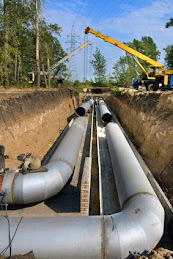Storm drains are specialized drainage systems which are designed to handle an excess of water as a result of flooding or heavy rainfall. They are frequently found in major cities, especially in flood prone areas. A number of systems are used for the collection and ultimate discharge of water from storm drains, and if there are storm drains in your area, it may be interesting for you to learn about how the water is processed before it is discharged.
When rainfall is heavy, the streets, parking lots, and other flat areas of a town can flood. In addition to the water falling directly on these surfaces, gutters also discharge large amounts of water into the street. The flooding can pose a hazard, which is why storm strains are installed. The storm drains are frequently located on either side of a street, at a low point in the roadway where water would naturally collect. Typically, a large grate covers the storm drain, which takes the form of a giant pipe.
In some parts of the world, storm drains are known as storm water drains or a surface water system. Water flows down the pipes and meets up with other pipes, creating an ever larger central pipe. In many areas, the storm drain system is kept entirely separate from the sewer system. The outlet for the pipe is found by a lake, ocean, or other major body of water. In other cases, storm drains are connected with the sewer system, and the water from the drains is processed before it is disposed of.
When water from the storm drains flows into a body of water, it can potentially distribute flooding to locations downstream, in the case of a river. It also poses a major pollution risk, because spills in the streets will be carried through the unfiltered storm drain system. For this reason, people are warned to stay away from storm drains and outlets for their health. Many storm drains also have signs above them which say “No dumping, drains to ocean” to remind people to protect their waterways by disposing of pollutants responsibly.
When a storm drain is linked with the sewage system and the water level is controllable, the processing offered by the sewage treatment plant is beneficial. However, if water levels start to rise beyond the capacity of the system, backups can cause the discharge of raw sewage into streets and waterways. For this reason, cities which chose to interconnect the storm drain and sewage systems must have protections in place to ensure the safety of the water supply.
Zonzini Pipeline & Sewer Services are your #1 source for storm drain repair and maintenance in New York! They have the experience to meet all your storm drain cleaning needs! Choose them for all your storm drain needs!
Subscribe to:
Post Comments (Atom)

No comments:
Post a Comment